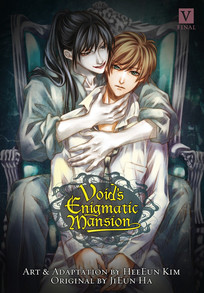Review
by Rebecca Silverman,Void's Enigmatic Mansion
GN 5
| Synopsis: |  |
||
Almost all of the secrets of the mansion have been revealed, from true natures to the dangers of what we desire. Now it is time to learn the history of the men behind it all – the mysterious pale nobleman…and the melancholy but kind Lavelle. What are their stories? How are they linked? Once again, be careful what you wish for in this final volume of Void's Enigmatic Mansion. |
|||
| Review: | |||
Whether it's a monkey's paw or a magic lamp, all stories about wishes remind us that a wish can be as much curse as gift. That's a theme that's been explored in all four previous volumes of Hee-eun Kim and JiEun Ha's Victorian-set manhwa Void's Enigmatic Mansion, and it comes back to haunt this final book. While the reveal about Lavelle, the young man who has slowly been revealed to be at the center of everything going on in the mansion, isn't as heart-wrenching as Mrs. Audrey's tale or that of the couple who lived across the hall from him, it still makes for melancholy reading as we discover just why he's been granting a single wish to all who ask – and how long he's been doing it for. In the previous volume, we learned the story of Lavelle's friend Dr. Juist, the character who has, alongside Lavelle and the pale duke, been in the series the longest. What you may not remember is that he played a very important role in the opening pages of volume one, something you may want to revisit before reading this book. Juist's murderous spree, brought on by the trauma of his wife's death at his hands (as he saw it) has deliberately conjured up images of 1888's most famous killings, those of Jack the Ripper, which seems to be deliberate even though this series is set in 1882. The fact that he's a physician and surgeon (two different things at this point in history) feeds into one Ripper identity theory, making the story's conclusion in this book feel oddly relevant to Victorian history. Given who remains at the end of the series, it also feels like we readers were given a preview of what's to come, but also another real-world reference to hold on to, like Louise as Frankenstein's Monster or the Elizabeth Gaskell-style family drama of Mrs. Audrey's story. While Void's Enigmatic Mansion doesn't feel like it's on the level of those 19th century classics, the deliberate references to them are part of what makes the series interesting, and in the case of Louise, more bittersweet as she fulfills her role in this volume. The greatest strength of this series is the way that it intertwines with fiction of the period and a basic folkloric sensibility. As readers of folktales know, most of them have not just teeth, but sharp fangs, and Void's Enigmatic Mansion has never shied away from dark resolutions to its stories. This volume does bring back all of the wishes from the previous books in an effort to bring closure to the denizens of the mansion, and the varying degrees of happiness that we see mirror not only Lavelle's own story (specifically Adolf's tale, particularly in terms of how his wife's wish became more of a curse), but also lessons taught by folklore. As I mentioned before, there are direct links to novels, but we also see threads of such texts as “Coppelia,” “The Princess Who Never Laughed,” and “The Pied Piper of Hamlin,” the last most specifically in terms of its lesson: you must always pay the piper. The reveal of who that piper is is perhaps the least satisfying element of the story – it hasn't been terribly mysterious, after all, so what we really want to know is why. Neither Lavelle's past nor the actual conclusion of the book truly provides this answer, nor a reason for the duke's vampiric appearance, which takes away from the ending somewhat. Although the story itself is strong, it's really the art that makes this series stand out. Inked and colored digitally (and with the strong possibility that the initial drawing is digital as well), Yen Press' full-color release is strikingly beautiful, even if you prefer your comics in black and white. For the most part the digital nature of the art isn't noticeable unless you're looking for it; the exception is when Kim uses blurring to denote movement, which doesn't quite work. While the people can be stiff at times, each character is distinct and the color helps to show off the opulence of the era while also giving the story the feel of a fairy tale picture book. Kim plays with panel layouts and page set up in this volume with more two-page spreads and full page illustrations, which again works well for the more magical aspects of the finale and gives a more dreamlike quality to the story of Lavelle's past. All in all, Void's Enigmatic Mansion's final volume doesn't bring quite enough closure to its story, but it comes close enough to make it feel like reading the series has been worthwhile. The literary allusions and folkloric lessons, along with humanity's never-ending failure to learn from their mistakes, makes this both fascinating and a bit depressing – but in a good way, if you can imagine it. It may not fulfill all of our wishes as readers, but maybe that's not such a tragedy. After all, getting precisely what you wish for can backfire in the most surprising ways. |
| Grade: | |||
|
Overall : B+
Story : B+
Art : A-
+ Threads tie together to bring more resolution to each character's story, interesting literary allusions and folkloric themes, gorgeous art |
|||
| discuss this in the forum (2 posts) | | |||
| Production Info: | ||
|
Full encyclopedia details about Release information about |
||